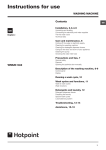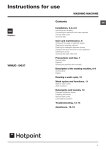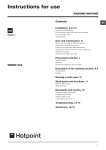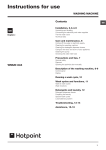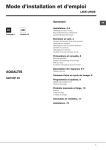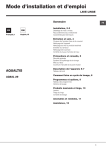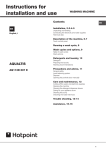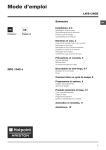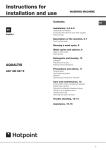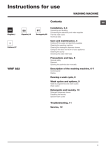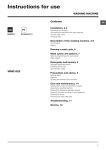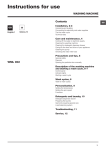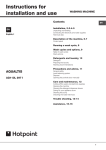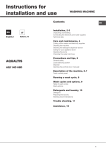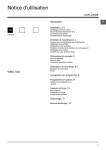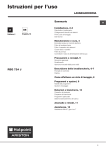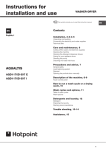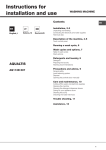Download Instructions for use
Transcript
Instructions for use WASHING MACHINE Contents GB English,1 IT Itaiiano,13 GB Installation, 2-3 Unpacking and levelling Connecting the electricity and water supplies The first wash cycle Technical data Description of the washing machine, 4-5 Control panel Display Running a wash cycle, 6 Wash cycles and functions, 7 Table of wash cycles Wash functions WMD 923 Detergents and laundry, 8 Detergent dispenser drawer Preparing the laundry Special wash cycles Load balancing system Precautions and tips, 9 General safety Disposal Opening the porthole door manually Care and maintenance, 10 Cutting off the water or electricity supply Cleaning the washing machine Cleaning the detergent dispenser drawer Caring for the door and drum of your appliance Cleaning the pump Checking the water inlet hose Troubleshooting, 11 Service, 12 1 Installation GB ! This instruction manual should be kept in a safe place for future reference. If the washing machine is sold, transferred or moved, make sure that the instruction manual remains with the machine so that the new owner is able to familiarise himself/herself with its operation and features. ! Read these instructions carefully: they contain vital information relating to the safe installation and operation of the appliance. Unpacking and levelling Unpacking 1. Remove the washing machine from its packaging. 2. Make sure that the washing machine has not been damaged during the transportation process. If it has been damaged, contact the retailer and do not proceed any further with the installation process. 3. Remove the 4 protective screws (used during transportation) and the rubber washer with the corresponding spacer, located on the rear part of the appliance (see figure). 4. Close off the holes using the plastic plugs provided. 5. Keep all the parts in a safe place: you will need them again if the washing machine needs to be moved to another location. ! Packaging materials should not be used as toys for children. Connecting the electricity and water supplies Connecting the water inlet hose 1. Connect the supply pipe by screwing it to a cold water tap using a ¾ gas threaded connection (see figure). Before performing the connection, allow the water to run freely until it is perfectly clear. 2. Connect the inlet hose to the washing machine by screwing it onto the corresponding water inlet of the appliance, which is situated on the top right-hand side of the rear part of the appliance (see figure). 3. Make sure that the hose is not folded over or bent. ! The water pressure at the tap must fall within the values indicated in the Technical details table (see page 3). ! If the inlet hose is not long enough, contact a specialised Levelling shop or an authorised technician. 1. Install the washing machine on a flat sturdy floor, without resting it up against walls, furniture cabinets or anything else. 2. If the floor is not perfectly level, compensate for any unevenness by tightening or loosening the adjustable front feet (see figure); the angle of inclination, measured in relation to the worktop, must not exceed 2°. 2 Levelling the machine correctly will provide it with stability, help to avoid vibrations and excessive noise and prevent it from shifting while it is operating. If it is placed on carpet or a rug, adjust the feet in such a way as to allow a sufficient ventilation space underneath the washing machine. ! Never use second-hand hoses. ! Use the ones supplied with the machine. ! Do not use extension cords or multiple sockets. Connecting the drain hose 65 - 100 cm Connect the drain hose, without bending it, to a drainage duct or a wall drain located at a height between 65 and 100 cm from the floor; GB ! The cable should not be bent or compressed. ! The power supply cable must only be replaced by authorised technicians. Warning! The company shall not be held responsible in the event that these regulations are not respected. The first wash cycle alternatively, rest it on the side of a washbasin or bathtub, fastening the duct supplied to the tap (see figure). The free end of the hose should not be underwater. Once the appliance has been installed, and before you use it for the first time, run a wash cycle with detergent and no laundry, using the wash cycle “Auto Clean” (see “Cleaning the washing machine”). ! We advise against the use of hose extensions; if it is absolutely necessary, the extension must have the same diameter as the original hose and must not exceed 150 cm in length. Technical data Model WMD 923 Electrical connections Dimensions Before plugging the appliance into the electricity socket, make sure that: width 59.5 cm height 85 cm depth 60,5 cm Capacity from 1 to 9 kg Electrical please refer to the technical data plate fixed to the machine • the socket is earthed and complies with all applicable laws; • the socket is able to withstand the maximum power load of the appliance as indicated on the Technical Data Plate fixed on the machine; • the power supply voltage falls within the values indicated on the Technical Data Plate fixed on the machine; connections Water connections maximum pressure 1 MPa (10 bar) minimum pressure 0.05 MPa (0.5 bar) drum capacity 71 litres Spin speed up to 1200 rotations per minute Test wash cycles in accordance • the socket is compatible with the plug of the washing machine. If this is not the case, replace the socket or the plug. ! The washing machine must not be installed outdoors, even in covered areas. It is extremely dangerous to leave the appliance exposed to rain, storms and other weather conditions. with directives 1061/2010 and programme ; temperature 60°C (2nd press of the button); temperature 40°C (3rd press of the button). 1015/2010 This appliance conforms to the following EC Directives: - 2004/108/EC (Electromagnetic Compatibility) - 2006/95/EC (Low Voltage) - 2002/96/EC ! When the washing machine has been installed, the electricity socket must be within easy reach. 3 Description of the washing machine GB Control panel CLEANING ACTION ON/OFF button button SPIN SPEED button DISPLAY Detergent dispenser drawer WASH CYCLE SELECTOR MY CYCLE button START/PAUSE button with indicator light FUNCTION buttons buttons ANTI ALLERGY RINSE button DELAY TIMER button TEMPERATURE button CHILD LOCK button Detergent dispenser drawer: used to dispense detergents and washing additives (see “Detergents and laundry”). TEMPERATURE button : press to decrease the temperature: the value will be shown on the display. ON/OFF button : press this briefly to switch the machine on or off. The START/PAUSE indicator light, which flashes slowly in a green colour shows that the machine is switched on. To switch off the washing machine during the wash cycle, press and hold the button for approximately 3 seconds; if the button is pressed briefly or accidentally the machine will not switch off. If the machine is switched off during a wash cycle, this wash cycle will be cancelled. CHILD LOCK button : to activate the control panel lock, press and hold the button for approximately 2 seconds. When the symbol is illuminated, the control panel is locked. This means it is possible to prevent wash cycles from being modified accidentally, especially where there are children in the home. To deactivate the control panel lock, press and hold the button for approximately 2 seconds. WASH CYCLE SELECTOR buttons: used to set the desired wash cycle (see “Table of wash cycles”). DELAY TIMER button : press to set a delayed start time for the selected wash cycle. The delay time will be shown on the display. MY CYCLE button: press and hold the button to store a cycle with your own set of preferences in the memory of the machine. To recall a previously stored cycle, press the MY CYCLE button. FUNCTION buttons: press the button to select the desired function. The corresponding indicator light on the display will switch on. CLEANING ACTION button wash intensity. ANTI ALLERGY RINSE button the desired rinse type. : to select the desired : press to select SPIN button : press to reduce or completely exclude the spin cycle - the value is indicated on the display. 4 START/PAUSE button with indicator light: when the green indicator light flashes slowly, press the button to start a wash cycle. Once the cycle has started the indicator light will remain lit in a fixed manner. To pause the wash cycle, press the button again; the indicator light will flash in an orange colour. If the symbol is not illuminated, the door may be opened. To start the wash cycle from the point at which it was interrupted, press the button again. Standby mode This washing machine, in compliance with new energy saving regulations, is fitted with an automatic standby system which is enabled after about 30 minutes if no activity is detected. Press the ON-OFF button briefly and wait for the machine to start up again. Consumption in off-mode: 1 W Consumption in Left-on: 1 W Display GB Z B A X D C E Y F The display is useful when programming the machine and provides a great deal of information. The two upper strings A and B provide details of the wash cycle selected, the wash cycle phase in progress and all information relating to the progress status of the wash cycle. String C shows the time remaining until the end of the wash cycle in progress and, if a DELAYED START has been set, the time remaining until the start of the selected wash cycle. String D shows the maximum spin speed value (this depends on the selected wash cycle); if the wash cycle does not include a spin cycle, the string remains unused. String E shows the maximum temperature value which may be selected (this depends on the wash cycle used); if the temperature of the wash cycle cannot be modified, the string remains unused. Indicator lights F correspond to the functions and light up when the selected function is compatible with the set wash cycle. Door locked symbol If the symbol is lit, this indicates that the washing machine door is locked to prevent it from being opened accidentally. To prevent any damage from occurring, wait for the symbol to switch itself off before opening the appliance door. N.B.: if the DELAYE TIMER function has been activated, the door cannot be opened; pause the machine by pressing the START/PAUSE button if you wish to open it. ! The first time the machine is switched on, you will be asked to select the language and the display will automatically show the language selection menu. To select the desired language press the X and Y buttons; to confirm the selection press the Z button. To change the language switch off the machine and press buttons X, Y, Z simultaneously until an alarm is heard: the language-selection menu will be displayed again. 5 Running a wash cycle GB 1.SWITCH THE MACHINE ON. Press the On/Off button ; the text POWER ON will appear on the display and the START/PAUSE indicator light will flash slowly in a green colour. 2. LOAD THE LAUNDRY. Open the porthole door. Load the laundry, making sure you do not exceed the maximum load value indicated in the table of programmes on the following page. 3.MEASURE OUT THE DETERGENT. Open the detergent dispenser drawer and pour the detergent into the relevant compartments as described in “Detergents and laundry”. 4. CLOSE THE DOOR. 5.SELECT THE WASH CYCLE. Press one of the WASH CYCLE SELECTOR buttons to select the required wash cycle; the name of the wash cycle will appear on the display. A temperature and spin speed is set for each wash cycle; these may be adjusted. The duration of the cycle will appear on the display. 6.CUSTOMISE THE WASH CYCLE. Use the relevant buttons: Modifying the temperature and/or spin speed. The machine automatically selects the maximum temperature and spin speed set for the selected wash cycle; these values cannot therefore be increased. The temperature can be decreased by pressing the button, until the cold wash “OFF” setting is reached. The spin speed may be progressively reduced by pressing the button, until it is completely excluded (the “OFF” setting). If these buttons are pressed again, the maximum values are restored. ! Exception: if the (60°C) (2nd press of the button) programme is selected, the temperature can be increased up to a value of 90°C. Setting a delayed start. To set a delayed start for the selected programme, press the corresponding button repeatedly until the required delay period has been reached. When this option is enabled, the symbol lights up on the display. To remove the delayed start function press the button until the text “OFF” appears on the display. Set the desired wash intensity. Option makes it possible to optimise washing based on the level of soil in the fabrics and on desired wash cycle intensity. Select the wash programme: the cycle will be automatically set to “Normal” as optimised for garments with an average level of soil (this setting is not applicable to the “Wool” cycle, which is automatically set to “Delicate”). For heavily-soiled garments press button until the “Super Wash” level is reached. This level ensures a high-performance wash due to a larger quantity of water used in the initial phase of the cycle and due to increased drum rotation. It is useful when removing the most stubborn stains. It can be used with or without bleach. If you wish to bleach the items insert the additional compartment (4) into compartment 1. When pouring the bleach, be careful not to exceed the “max” level marked on the central pivot (see figure pag. 8). 6 For lightly-soiled garments or a more delicate treatment of the fabrics, press button “ ” until the “Delicate” level is reached. The cycle will reduce the drum rotation to ensure washing results are perfect for delicate garments. If the current selection can be neither set nor changed, the display will show “Not allowed”. Set the rinse type. Option makes it possible to select the desired rinse type for sensitive skin. Press the button once for the “Extra Rinse” level, which makes it possible to select an additional rinse after the standard cycle rinse and remove all traces of detergent. Press the button again for the “Sensitive Skin” level, which makes it possible to select two additional rinses to the standard cycle rinses; it is recommended for very sensitive skin. Press the button for the third time for the “Anti allergy Rinse” level, which makes it possible to select three additional rinses to the standard cycle rinses and remove major allergens such as pollen, mites, cat and dog hair. Press the button again to go back to the “Normal Rinse” rinse type. If the current adjustment can be neither set nor changed, the display will show “Not allowed”. Modifying the cycle settings. • Press the button to enable the function; the indicator light corresponding to the button will switch on. • Press the button again to disable the function; the indicator light will switch off. ! If the selected function is not compatible with the programmed wash cycle, the indicator light will flash and the function will not be activated. ! If the selected function is not compatible with another function which has been selected previously, the indicator light corresponding to the first function selected will flash and only the second function will be activated; the indicator light corresponding to the enabled function will remain lit. ! The functions may affect the recommended load value and/or the duration of the cycle. 7. START THE PROGRAMME. Press the START/PAUSE button. The corresponding indicator light will become green, remaining lit in a fixed manner, and the door will be locked (the DOOR LOCKED symbol will be on). During the wash cycle, the name of the phase in progress will appear on the display. To change a wash cycle while it is in progress, pause the washing machine using the START/PAUSE button (the START/PAUSE indicator light will flash slowly in an orange colour); then select the desired cycle and press the START/PAUSE button again. To open the door while a cycle is in progress, press the START/PAUSE button; if the DOOR LOCKED symbol is switched off the door may be opened. Press the START/PAUSE button again to restart the wash cycle from the point at which it was interrupted. 8.THE END OF THE WASH CYCLE. This will be indicated by the text “END OF CYCLE” on the display; when the DOOR LOCKED symbol switches off the door may be opened. Open the door, unload the laundry and switch off the machine. ! If you wish to cancel a cycle which has already begun, press and hold the button. The cycle will be stopped and the machine will switch off. Wash cycles and functions Total water lt Cycle duration Residual dampness % Energy consumption kWh 190’ Max. load (kg) - Fabric softener Anti Stain 40° Cotton Prewash (1st press of the button): extremely soiled whites 90° and resistant colours. White Cottons (1) (2nd press of the button): heavily soiled whites 60° and delicate colours. (Max. 90°C) Cottons Coloured (1-2) (3rd press of the button): lightly soiled whi40° tes and delicate colours. Synthetics Resistant (1st press of the button): heavily soiled resi60° stant colours. Synthetics Resistant (4) (1st press of the button): heavily soiled 40° resistant colours. Synthetics Delicate (2nd press of the button): lightly soiled resistant 40° colours. Fastwash 60' (1st press of the button): to refresh normal soiled garments quickly (not suitable for wool, silk and clothes which 60° require washing by hand). Fastwash 30' (2nd press of the button): to refresh lightly soiled garments quickly (not suitable for wool, silk and clothes which 30° require washing by hand). M My Cycle: allows for any wash cycle to be stored. Max. speed (rpm) Bleach Max. temp. (°C) Description of the wash cycle Wash Detergents PreWash Wash cycles Table of wash cycles 1200 - - 6 - 1200 - 9 53 2,01 101 205’ 1200 - 9 53 1,09 79 175’ 1200 - 9 53 0,85 82 170’ 800 - 5 48 0,99 57 115’ 800 - 5 48 0,63 55 95’ 800 - 5 - - - 80’ 1200 - - 4 53 0,54 57 60’ 800 - - 4 71 0,21 41 30’ - Bed & Bath (3): washes bathroom laundry and bedlinen. 60° 1200 - - 9 - - - 150’ Woolmark Platinum (Wool): for wool, cashmere, etc. Ultradelicates 40° 800 - - 2,5 - - - 100’ 30° 0 - - 1 - - - 80’ Fast spin Cottons (1st press of the button) - 1200 - - - - 9 - - - 16’ Rinse Cottons (2nd press of the button) - 1200 - - - 9 - - - 49’ Pump out (3rd press of the button) - 0 - - - - 9 - - - 2’ The length of cycle shown on the display or in this booklet is an estimation only and is calculated assuming standard working conditions. The actual duration can vary according to factors such as water temperature and pressure, the amount of detergent used, the amount and type of load inserted, load balancing and any wash options selected. For all Test Institutes: 1) Test wash cycle in compliance with directive 1061/2010: set wash cycle 60°C (2nd press of the button); set wash cycle 40°C (3rd press of the button). This cycle is designed for cotton loads with a normal soil level and is the most efficient in terms of both electricity and water consumption; it should be used for garments which can be washed at 60°C and 40°C. The actual washing temperature may differ from the indicated value. 2) Long wash cycle for cottons: set wash cycle 3) Short wash cycle for cottons: set wash cycle 4) Long wash cycle for synthetics: set wash cycle 40°C (3rd press of the button). ; temperature of 40°C (press TEMPERATURE button). 60°C (1st press of the button); temperature of 40°C (press TEMPERATURE button). Wash functions Time Saver If you select this option, the wash cycle duration will be reduced by up to 50%, depending on the selected cycle, thereby guaranteeing simultaneous water and energy saving. Use this cycle for lightly soiled garments. ! It cannot be used with the , “Fastwash 60’”, , , . Easy Iron By selecting this function, the wash and spin cycles will be modified in order to reduce the formation of creases. At the end of the cycle the washing machine will perform slow rotations of the drum; the “Easy Iron” indicator light will flash and the text “END OF CYCLE” will appear on the display. To end the cycle, press the START/PAUSE button or the “Easy Iron” button. ! It cannot be used with the , “Fastwash 30’”, “Fast spin Resistents” and “Pump out”. , Eco Wash The Eco Wash function saves energy by not heating the water used to wash your laundry – an advantage both to the environment and to your energy bill. Instead, intensified wash action and water optimisation ensure great wash results in the same average time of a standard cycle. For the best washing results we recommend the usage of a liquid detergent. ! It cannot be used with the , (90°C), , , , . , 7 GB Detergents and laundry GB Detergent dispenser drawer Special wash cycles Good washing results also depend on the correct dose of detergent: adding too much detergent will not necessarily result in a more efficient wash, and may in fact cause a build up on the inside of your appliance and contribute to environmental pollution. Anti Stain : this programme is suitable to heavily-soiled garments with resistant colours. It ensures a washing class that is higher than the standard class (A class). When running the programme, do not mix garments of different colours. We recommend the use of powder detergent. Pre-treatment with special additives is recommended if there are obstinate stains. Bed & Bath: use programme to wash bed linen and towels in one single cycle: it optimises softener performance and helps you save time and energy. We recommend the use of powder detergent. Wool: the wool wash cycle on this Hotpoint-Ariston machine has been tested and approved by The Woolmark Company for washing wool garments labelled as hand washable provided that the garments are washed according to the instructions on the garment label and those issued by the manufacturer of this washing machine. Hotpoint-Ariston is the first washing machine brand to be approved by The Woolmark Company for Apparel CarePlatinum for its washing performance and consumption of energy and water. (M1135) ! Use powder detergent for white cotton garments, for prewashing, and for washing at temperatures over 60°C. ! Follow the instructions given on the detergent packaging. ! Do not use hand washing detergents; they create too much foam. A B MAX 4 Open the detergent dispenser drawer and pour in the detergent or washing additive, as follows. 1 3 2 compartment 1: Pre-wash detergent (powder) Before pouring in the detergent, make sure that extra compartment 4 has been removed. compartment 2: Detergent for the wash cycle (powder or liquid) If liquid detergent is used, it is recommended that the removable plastic partition A (supplied) be used for proper dosage. If powder detergent is used, place the partition into slot B. compartment 3: Additives (fabric softeners, etc.) The fabric softener should not overflow the grid. extra compartment 4: Bleach Preparing the laundry • Divide the laundry according to: - the type of fabric/the symbol on the label - the colours: separate coloured garments from whites. • Empty all garment pockets and check the buttons. • Do not exceed the listed values, which refer to the weight of the laundry when dry: Durable fabrics: max. 9 kg Synthetic fabrics: max. 5 kg Wool: max. 2,5 kg Silk: max. 2,5 kg How much does your laundry weigh? 8 1 sheet 400-500 g 1 pillow case 150-200 g 1 tablecloth 400-500 g 1 bathrobe 900-1200 g 1 towel 150-250 g ltradelicates: use programme to wash very delicate garments having strasses or sequins. To wash Silk garments and Curtains select the cycle and set the “Delicate” level from option . We recommend turning the garments inside out before washing and placing small items into the special bag for washing delicates. Use liquid detergent on delicate garments for best results. Load balancing system Before every spin cycle, to avoid excessive vibrations and to distribute the load in a uniform manner, the drum rotates continuously at a speed which is slightly greater than the washing rotation speed. If, after several attempts, the load is not balanced correctly, the machine spins at a reduced spin speed. If the load is excessively unbalanced, the washing machine performs the distribution process instead of spinning. To encourage improved load distribution and balance, we recommend small and large garments are mixed in the load. Precautions and tips ! This washing machine was designed and constructed in accordance with international safety regulations. The following information is provided for safety reasons and must therefore be read carefully. Opening the porthole door manually General safety • This appliance was designed for domestic use only. • This appliance is not intended for use by persons (including children) with reduced physical, sensory or mental capabilities, or lack of experience and knowledge, unless they have been given supervision or instruction concerning use of the appliance by a person responsible for their safety. Children should be supervised to ensure that they do not play with the appliance. • Do not touch the machine when barefoot or with wet or damp hands or feet. • Do not pull on the power supply cable when unplugging the appliance from the electricity socket. Hold the plug and pull. • Do not open the detergent dispenser drawer while the machine is in operation. GB In the event that it is not possible to open the porthole door due to a powercut, and if you wish to remove the laundry, proceed as follows: 20 1. remove the plug from the electrical socket. 2. make sure the water level inside the machine is lower than the door opening; if it is not, remove excess water using the drain hose, collecting it in a bucket as indicated in the figure. 3. using a screwdriver, remove the cover panel on the lower front part of the washing machine (see figure). • Do not touch the drained water as it may reach extremely high temperatures. • Never force the porthole door. This could damage the safety lock mechanism designed to prevent accidental opening. • If the appliance breaks down, do not under any circumstances access the internal mechanisms in an attempt to repair it yourself. • Always keep children well away from the appliance while it is operating. • The door can become quite hot during the wash cycle. • If the appliance has to be moved, work in a group of two or three people and handle it with the utmost care. Never try to do this alone, because the appliance is very heavy. • Before loading laundry into the washing machine, make sure the drum is empty. Disposal •Disposing of the packaging materials: observe local regulations so that the packaging may be re-used. 4. pull outwards using the tab as indicated in the figure, until the plastic tie-rod is freed from its stop position; pull downwards and open the door at the same time. 5. reposition the panel, making sure the hooks are securely in place before you push it onto the appliance. •The European Directive 2002/96/EC on Waste Electrical and Electronic Equipment, requires that old household electrical appliances must not be disposed of in the normal unsorted municipal waste stream. Old appliances must be collected separately in order to optimise the recovery and recycling of the materials they contain and reduce the impact on human health and the environment. The crossed out “wheeled bin” symbol on the product reminds you of your obligation, that when you dispose of the appliance it must be separately collected. Consumers should contact their local authority or retailer for information concerning the correct disposal of their old appliance. 9 Care and maintenance GB Cutting off the water and electricity supplies Caring for the door and drum of your appliance • Turn off the water tap after every wash cycle. This will limit wear on the hydraulic system inside the washing machine and help to prevent leaks. • Always leave the porthole door ajar in order to prevent unpleasant odours from forming. • Unplug the washing machine when cleaning it and during all maintenance work. Cleaning the washing machine • The outer parts and rubber components of the appliance can be cleaned using a soft cloth soaked in lukewarm soapy water. Do not use solvents or abrasives. • The washing machine has a “Auto Clean” programme for its internal parts that must be run with no load in the drum. For maximum performance you may want to use either the detergent (i.e. a quantity 10% the quantity specified for lightly-soiled garments) or special additives to clean the washing machine. We recommend running a cleaning programme every 40 wash cycles. To start the programme press buttons A and B simultaneously for 5 seconds (see figure). The programme will start automatically and will last approximately 70 minutes. To stop the cycle press the START/ PAUSE button. A B Cleaning the pump The washing machine is fitted with a self-cleaning pump which does not require any maintenance. Sometimes, small items (such as coins or buttons) may fall into the pre-chamber which protects the pump, situated in its bottom part. ! Make sure the wash cycle has finished and unplug the appliance. To access the pre-chamber: 1. using a screwdriver, remove the cover panel on the lower front part of the washing machine (see figure); 2. unscrew the lid by rotating it anti-clockwise (see figure): a little water may trickle out. This is perfectly normal; Cleaning the detergent dispenser drawer Remove the dispenser by raising it and pulling it out (see figure). Wash it under running water; this operation should be repeated frequently. 1 2 3. clean the inside thoroughly; 4. screw the lid back on; 5. reposition the panel, making sure the hooks are securely in place before you push it onto the appliance. Checking the water inlet hose Check the inlet hose at least once a year. If there are any cracks, it should be replaced immediately: during the wash cycles, water pressure is very strong and a cracked hose could easily split open. ! Never use second-hand hoses. 10 Troubleshooting Your washing machine could fail to work. Before contacting the Technical Assistance Centre (see “Assistance”), make sure that the problem cannot be solved easily using the following list. GB Problem: Possible causes / Solutions: The washing machine does not switch on. • The appliance is not plugged into the socket fully, or is not making contact. • There is no power in the house. The wash cycle does not start. • The washing machine door is not closed properly. • The ON/OFF button has not been pressed. • The START/PAUSE button has not been pressed. • The water tap has not been opened. • A delayed start has been set (see “Running a wash cycle”). The washing machine does not take in water (the text “NO WATER, CHECK SUPPLY” appears on the display). • The water inlet hose is not connected to the tap. • The hose is bent. • The water tap has not been opened. • There is no water supply in the house. • The pressure is too low. • The START/PAUSE button has not been pressed. The washing machine continuously takes in and drains water. • The drain hose is not fitted at a height between 65 and 100 cm from the floor (see “Installation”). • The free end of the hose is under water (see “Installation”). • The wall drainage system is not fitted with a breather pipe. If the problem persists even after these checks, turn off the water tap, switch the appliance off and contact the Assistance Service. If the dwelling is on one of the upper floors of a building, there may be problems relating to water drainage, causing the washing machine to fill with water and drain continuously. Special anti-draining valves are available in shops and help to avoid this inconvenience. The washing machine does not drain or spin. • The wash cycle does not include draining: some wash cycles require the drain phase to be started manually (see “Wash cycles and functions”). • The EASY IRON function has been activated: To complete the wash cycle, press the START/PAUSE button (see “Wash cycles and functions”). • The drain hose is bent (see “Installation”). • The drainage duct is clogged. The washing machine vibrates a lot during the spin cycle. • The drum was not unlocked correctly during installation (see “Installation”). • The washing machine is not level (see “Installation”). • The washing machine is trapped between cabinets and walls (see “Installation”). The washing machine leaks. • The water inlet hose is not screwed on properly (see “Installation”). • The detergent dispenser drawer is blocked (for cleaning instructions, see “Care and maintenance”). • The drain hose is not fixed properly (see “Installation”). The machine is locked and the display flashes, indicating an error code (e.g. F-01, F-..). • Switch off the machine and unplug it, wait for approximately 1 minute and then switch it back on again. If the problem persists, contact the Technical Assistance Service. There is too much foam. • The detergent is not suitable for machine washing (it should display the text “for washing machines” or “hand and machine wash”, or the like). • Too much detergent was used. 11 Service GB Before calling for Assistance: • Check whether you can solve the problem alone (see “Troubleshooting”); • Restart the programme to check whether the problem has been solved; • If this is not the case, contact an authorised Technical Assistance Centre using the telephone number provided on the guarantee certificate. ! Always request the assistance of authorised technicians. Have the following information to hand: • the type of problem; • the appliance model (Mod.); • the serial number (S/N). This information can be found on the data plate applied to the rear of the washing machine, and can also be found on the front of the appliance by opening the door. 12 Istruzioni per l’uso LAVABIANCHERIA Sommario I Italiano I Installazione, 14-15 Disimballo e livellamento Collegamenti idraulici ed elettrici Primo ciclo di lavaggio Dati tecnici Descrizione della lavabiancheria, 16-17 Pannello di controllo Display Come effettuare un ciclo di lavaggio, 18 Programmi e funzioni, 19 Tabella dei programmi Funzioni di lavaggio Detersivi e biancheria, 20 WMD 923 Cassetto dei detersivi Preparare la biancheria Programmi particolari Sistema bilanciamento del carico Precauzioni e consigli, 21 Sicurezza generale Smaltimento Apertura manuale della porta oblò Manutenzione e cura, 22 Escludere acqua e corrente elettrica Pulire la lavabiancheria Pulire il cassetto dei detersivi Curare oblò e cestello Pulire la pompa Controllare il tubo di alimentazione dell’acqua Anomalie e rimedi, 23 Assistenza, 24 Assistenza Attiva 7 giorni su 7 13 Installazione I ! È importante conservare questo libretto per poterlo consultare in ogni momento. In caso di vendita, di cessione o di trasloco, assicurarsi che resti insieme alla lavabiancheria per informare il nuovo proprietario sul funzionamento e sui relativi avvertimenti. ! Leggere attentamente le istruzioni: ci sono importanti informazioni sull’installazione, sull’uso e sulla sicurezza. Disimballo e livellamento Disimballo 1. Disimballare la lavabiancheria. 2. Controllare che la lavabiancheria non abbia subìto danni nel trasporto. Se fosse danneggiata non collegarla e contattare il rivenditore. 3. Rimuovere le 4 viti di protezione per il trasporto e il gommino con il relativo distanziale, posti nella parte posteriore (vedi figura). Un accurato livellamento dà stabilità alla macchina ed evita vibrazioni, rumori e spostamenti durante il funzionamento. In caso di moquette o di un tappeto, regolare i piedini in modo da conservare sotto la lavabiancheria uno spazio sufficiente per la ventilazione. Collegamenti idraulici ed elettrici Collegamento del tubo di alimentazione dell’acqua 1. Collegare il tubo di alimentazione avvitandolo a un rubinetto d’acqua fredda con bocca filettata da 3/4 gas (vedi figura). Prima di allacciare, far scorrere l’acqua finché non sia limpida. 2. Collegare il tubo di alimentazione alla lavabiancheria avvitandolo all’apposita presa d’acqua, nella parte posteriore in alto a destra (vedi figura). 4. Chiudere i fori con i tappi di plastica in dotazione. 5. Conservare tutti i pezzi: qualora la lavabiancheria debba essere trasportata, dovranno essere rimontati. 3. Fare attenzione che nel tubo non ci siano né pieghe né strozzature. ! Gli imballaggi non sono giocattoli per bambini. ! La pressione idrica del rubinetto deve essere compresa Livellamento ! Se la lunghezza del tubo di alimentazione non fosse 1. Installare la lavabiancheria su un pavimento piano e rigido, senza appoggiarla a muri, mobili o altro. 2. Se il pavimento non fosse perfettamente orizzontale, compensare le irregolarità svitando o avvitando i piedini anteriori (vedi figura); l’angolo di inclinazione, misurato sul piano di lavoro, non deve superare i 2°. 14 nei valori della tabella Dati tecnici (vedi pagina a fianco). sufficiente, rivolgersi a un negozio specializzato o a un tecnico autorizzato. ! Non utilizzare mai tubi già usati. ! Utilizzare quelli in dotazione alla macchina. Collegamento del tubo di scarico 65 - 100 cm Collegare il tubo di scarico, senza piegarlo, a una conduttura di scarico o a uno scarico a muro posti tra 65 e 100 cm da terra; ! Il cavo non deve subire piegature o compressioni. I ! Il cavo di alimentazione deve essere sostituito solo da tecnici autorizzati. Attenzione! L’azienda declina ogni responsabilità qualora queste norme non vengano rispettate. Primo ciclo di lavaggio oppure appoggiarlo al bordo di un lavandino o di una vasca, legando la guida in dotazione al rubinetto (vedi figura). L’estremità libera del tubo di scarico non deve rimanere immersa nell’acqua. Dopo l’installazione, prima dell’uso, effettuare un ciclo di lavaggio con detersivo e senza biancheria impostando il programma “Auto Pulizia” (vedi “Pulire la lavabiancheria”). ! È sconsigliato usare tubi di prolunga; se indispensabile, la prolunga deve avere lo stesso diametro del tubo originale e non superare i 150 cm. Dati tecnici Modello WMD 923 Dimensioni larghezza cm 59,5 altezza cm 85 profondità cm 60,5 Capacità da 1 a 9 kg Collegamenti elettrici Vedi targhetta caratteristiche tecniche applicata sulla macchina Collegamenti idrici • la tensione di alimentazione sia compresa nei valori indicati nella tabella Dati tecnici (vedi a fianco); pressione massima 1 MPa (10 bar) pressione minima 0,05 MPa (0,5 bar) capacità del cesto 71 litri Velocità di centrifuga sino a 1200 giri al minuto • la presa sia compatibile con la spina della lavabiancheria. In caso contrario sostituire la presa o la spina. Programmi di controllo secon- programma ; do la direttive temperatura 60°C (2° pressione del tasto); temperatura 40°C (3° pressione del tasto). 1061/2010 e 1015/2010 Collegamento elettrico Prima di inserire la spina nella presa della corrente, accertarsi che: • la presa abbia la messa a terra e sia a norma di legge; • la presa sia in grado di sopportare il carico massimo di potenza della macchina, indicato nella tabella Dati tecnici (vedi a fianco); ! La lavabiancheria non va installata all’aperto, nemmeno se lo spazio è riparato, perché è molto pericoloso lasciarla esposta a pioggia e temporali. ! A lavabiancheria installata, la presa della corrente deve essere facilmente raggiungibile. Questa apparecchiatura è conforme alle seguenti Direttive Comunitarie: - 2004/108/CE (Compatibilità Elettromagnetica) - 2006/95/CE (Bassa Tensione) - 2002/96/CE ! Non usare prolunghe e multiple. 15 Descrizione della lavabiancheria I Pannello di controllo Tasto ON/OFF Tasto TIPO DI LAVAGGIO Tasto CENTRIFUGA DISPLAY Tasti Cassetto dei detersivi SELETTORE PROGRAMMI Tasto Tasto con spia MY CYCLE START/PAUSE Tasti FUNZIONE Tasto Tasto TIPO DI RISCIACQUO TEMPERATURA Tasto Tasto PARTENZA PROGRAMMATA BLOCCI TASTI Cassetto dei detersivi: per caricare detersivi e additivi (vedi “Detersivi e biancheria”). Tasto TEMPERATURA : premere per ridurre la temperatura; il valore viene indicato nel display. Tasto ON/OFF : premere brevemente il tasto per accendere o spegnere la macchina. La spia START/PAUSE che lampeggia lentamente di colore verde indica che la macchina è accesa. Per spegnere la lavabiancheria durante il lavaggio è necessario tenere premuto il tasto più a lungo, circa 3 sec.; una pressione breve o accidentale non permetterà lo spegnimento della macchina. Lo spegnimento della macchina durante un lavaggio in corso annulla il lavaggio stesso. Tasto BLOCCO TASTI : per attivare il blocco del pannello di controllo, tenere premuto il tasto per circa 2 secondi. Il simbolo acceso indica che il pannello di controllo è bloccato. In questo modo si impediscono modifiche accidentali dei programmi, soprattutto se in casa ci sono dei bambini. Per disattivare il blocco del pannello di controllo, tenere premuto il tasto per circa 2 secondi. Tasti SELETTORE PROGRAMMI: per impostare il programma desiderato (vedi “Tabella dei programmi”). Tasto PARTENZA RITARDATA : premere per impostare una partenza ritardata del programma prescelto; il ritardo viene indicato nel display. Tasto MY CYCLE: tenere premuto il tasto per memorizzare un ciclo e le proprie personalizzazioni preferite. Per richiamare un ciclo precedentemente memorizzato premere il tasto MY CYCLE. Tasti FUNZIONE: premere il tasto per selezionare la funzione desiderata. Sul display si illuminerà la spia relativa. Tasto TIPO DI LAVAGGIO : premere per selezionare l’intensità di lavaggio desiderata. Tasto TIPO DI RISCIACQUO : premere per selezionare il tipo di risciacquo desiderato. Tasto CENTRIFUGA : premere per ridurre o escludere del tutto la centrifuga; il valore viene indicato nel display. 16 Tasto con spia START/PAUSE: quando la spia verde lampeggia lentamente, premere il tasto per avviare un lavaggio. A ciclo avviato la spia diventa fissa. Per mettere in pausa il lavaggio, premere nuovamente il tasto; la spia lampeggerà con colore arancione. Se il simbolo non è illuminato, si potrà aprire l’oblò. Per far ripartire il lavaggio dal punto in cui è stato interrotto, premere nuovamente il tasto. Modalità di stand by Questa lavatrice, in conformità alle nuove normative legate al risparmio energetico, è dotata di un sistema di autospegnimento (stand by) che entra in funzione dopo circa 30 minuti nel caso di non utilizzo. Premere brevemente il tasto ON/OFF e attendere che la macchina si riattivi. Consumo in off-mode: 1 W Consumo in Left-on: 1 W Display I Z B A X D C E Y F Il display è utile per programmare la macchina e fornisce molteplici informazioni. Nelle due stringhe superiori A e B vengono visualizzati il programma di lavaggio selezionato, la fase di lavaggio in corso e tutte le indicazioni relative allo stato d’avanzamento del programma. Nella stringa C viene visualizzato il tempo residuo alla fine del ciclo di lavaggio in corso e nel caso fosse stata impostata una PARTENZA RITARDATA, il tempo mancante all’avvio del programma selezionato. Nell’area D viene visualizzato il valore massimo della velocità della centrifuga che la macchina può effettuare in base al programma impostato; se il programma non prevede la centrifuga l’area resta spenta. Nell’area E viene visualizzato il valore massimo della temperatura che si può selezionare in base al programma impostato; se il programma non prevede l’impostazione della temperatura l’area resta spenta. Le spie F sono relative alle funzioni e si accendono quando la funzione selezionata è compatibile con il programma impostato. Simbolo Oblò bloccato Il simbolo acceso indica che l’oblò è bloccato per impedire aperture accidentali. Per evitare danni è necessario attendere che il simbolo si spenga prima di aprire l’oblò. N.B.: se è attiva la funzione PARTENZA RITARDATA l’oblo non si può aprire, per aprirlo mettere la macchina in pausa premendo il tasto START/PAUSE. ! Alla prima accensione verrà richiesto di selezionare la lingua ed il display entrerà automaticamente nel menu di selezione lingua. Per scegliere la lingua desiderata premere i tasti X e Y, per confermare la scelta premere il tasto Z. Se si vuole cambiare lingua, spegnere la macchina, premere contemporaneamente i tasti X, Y, Z fino a sentire un segnale acustico, verrà visualizzato di nuovo il menu di selezione lingua. 17 Come effettuare un ciclo di lavaggio I 1.ACCENDERE LA MACCHINA. Premere il tasto , sul display comparirà la scritta “ACCENSIONE IN CORSO”; la spia START/PAUSE lampeggia lentamente di colore verde. 2. CARICARE LA BIANCHERIA. Aprire la porta oblò. Caricare la biancheria facendo attenzione a non superare la quantità di carico indicata nella tabella programmi della pagina seguente. 3.DOSARE IL DETERSIVO. Estrarre il cassetto e versare il detersivo nelle apposite vaschette come spiegato in “Detersivi e biancheria”. 4. CHIUDERE L’OBLO’. 5. SCEGLIERE IL PROGRAMMA. Premere uno dei tasti del SELETTORE PROGRAMMI per selezionare il programma desiderato; il nome del programma comparirà sul display; ad esso è associata una temperatura e una velocità di centrifuga che possono essere modificate. Sul display comparirà la durata del ciclo. 6.PERSONALIZZARE IL CICLO DI LAVAGGIO. Agire sugli appositi tasti: Modificare la temperatura e/o la centrifuga. La macchina seleziona automaticamente la temperatura e la centrifuga massime previste per il programma impostato e non possono pertanto essere aumentate. Premendo il tasto si riduce progressivamente la temperatura sino al lavaggio a freddo “OFF”. Premendo il tasto si riduce progressivamente la centrifuga sino alla sua esclusione “OFF”. Un’ulteriore pressione dei tasti riporterà i valori al massimo consentito per il ciclo selezionato. ! Eccezione: selezionando il programma (60°C) (2° pressione del tasto) la temperatura può essere portata sino a 90°. Impostare una partenza ritardata. Per impostare la partenza ritardata del programma prescelto, premere il tasto relativo fino a raggiungere il tempo di ritardo desiderato. Quando tale opzione è attiva, sul display si illumina il simbolo . Per rimuovere la partenza ritardata premere il tasto fino a che sul display compare la scritta “OFF”. Impostare l’intensità di lavaggio desiderata. L’opzione permette di ottimizzare il lavaggio in base al grado di sporco dei tessuti e all’intensità di lavaggio desiderata. Selezionare il programma di lavaggio, il ciclo viene impostato automaticamente sul livello “Normale”, ottimizzato per capi mediamente sporchi, (impostazione non valida per il ciclo “Lana”, che si imposta automaticamente sul livello “Delicato”). Per capi molto sporchi premere il tasto fino al raggiungimento del livello “Lavaggio Intensivo”. Questo livello garantisce un lavaggio di alte prestazioni grazie all’utilizzo di una maggiore quantità di acqua nella fase iniziale del ciclo ed una maggiore movimentazione meccanica, ed è utile per eliminare le macchie più resistenti. Può essere utilizzato con o senza candeggina. Se si desidera effettuare il candeggio inserire la vaschetta aggiuntiva 4, in dotazione, nella vaschetta 1. Nel dosare la candeggina non superare il livello “max” indicato sul perno centrale (vedi figura a pag. 20). Per capi poco sporchi o per un trattamento più delicato dei tessuti, premere il tasto fino al raggiungimento del livello “Delicato”. Il ciclo ridurrà la movimentazione meccanica per garantire risultati di lavaggio perfetti per i 18 capi delicati. Se non è possibile impostare o modificare la regolazione esistente, sul display verrà visualizzato “Non permesso”. Impostare il tipo di risciacquo. L’opzione consente di selezionare il tipo di risciacquo desiderato per la massima cura delle pelli sensibili. Alla prima pressione del tasto viene impostato il livello “Extra risciacquo” che permette di selezionare un risciacquo aggiuntivo a quelli standard del ciclo, per eliminare tutte le tracce di detergente. Alla seconda pressione del tasto viene impostato il livello “Pelli Sensibili” che permette di selezionare due risciacqui aggiuntivi a quelli standard del ciclo ed è consigliato per le pelli più sensibili. Alla terza pressione del tasto viene impostato il livello “Anti Allergico” che permette di selezionare tre risciacqui aggiuntivi a quelli standard del ciclo, per rimuovere i principali allergeni come polline, acari, peli del gatto e cane. Premere nuovamente il tasto per tornare al tipo di risciacquo “Risciacquo Normale”. Se non è possibile impostare o modificare la regolazione esistente, sul display verrà visualizzato “Non permesso”. Modificare le caratteristiche del ciclo. • Premere il tasto per attivare la funzione; la spia corrispondente al pulsante si accenderà. • Premere nuovamente il tasto per disattivare la funzione; la spia si spegnerà. ! Se la funzione selezionata non è compatibile con il programma impostato, la spia lampeggerà e la funzione non verrà attivata. ! Se la funzione selezionata non è compatibile con un’altra precedentemente impostata, la spia relativa alla prima funzione selezionata lampeggerà e verrà attivata solo la seconda, la spia della funzione attivata si illuminerà. ! Le funzioni possono variare il carico raccomandato e/o la durata del ciclo. 7.AVVIARE IL PROGRAMMA. Premere il tasto START/PAUSE. La spia relativa si illuminerà di colore verde fisso e l’oblò si bloccherà (simbolo OBLO’BLOCCATO acceso). Durante il lavaggio, sul display comparirà il nome della fase in corso. Per cambiare un programma mentre un ciclo è in corso, mettere la lavabiancheria in pausa premendo il tasto START/PAUSE (la spia START/PAUSE lampeggerà lentamente di colore arancione); selezionare quindi il ciclo desiderato e premere nuovamente il tasto START/PAUSE. Per aprire la porta mentre un ciclo è in corso premere il tasto START/PAUSE; se il simbolo OBLO’BLOCCATO è spenta sarà possibile aprire l’oblò. Premere nuovamente il tasto START/PAUSE per far ripartire il programma dal punto in cui era stato interrotto. 8.FINE DEL PROGRAMMA. Viene indicata dalla scritta “FINE CICLO” sul display, quando il simbolo OBLO’BLOCCATO si spegnerà sarà possibile aprire l’oblò. Aprire l’oblò, scaricare la biancheria e spegnere la macchina. ! Se si desidera annullare un ciclo già avviato, premere a lungo il tasto . Il ciclo verrà interrotto e la macchina si spegnerà. Programmi e funzioni Tabella dei programmi I Lavaggio Candeggina Ammobidente Carico max. (Kg) Umidità residua % Consumo energia kWh Acqua totale lt Durata ciclo 1200 - - 6 - - - 190’ 1200 - 9 53 2,01 101 205’ 1200 - 9 53 1,09 79 175’ 1200 - 9 53 0,85 82 170’ 800 - 5 48 0,99 57 115’ 40° 800 - 5 48 0,63 55 Sintetici Delicati (2° pressione del tasto): colori resistenti poco sporchi. 40° Rapido 60' (1° pressione del tasto): per rinfrescare rapidamente capi 60° normalmente (non indicato per lana, seta e capi da lavare a mano). Rapido 30' (2° pressione del tasto): per rinfrescare rapidamente capi 30° poco sporchi (non indicato per lana, seta e capi da lavare a mano). M My Cycle (Memo): permette di memorizzare un qualsiasi ciclo di lavaggio. 800 - 5 - 1200 - - 4 53 0,54 57 60’ 800 - - 4 71 0,21 41 30’ Programmi Prelavaggio Detersivi Descrizione del Programma Velocità Temp. max. max. (°C) (giri al minuto) Antimacchia 40° Cotone Prelavaggio (1° pressione del tasto): bianchi estremamente 90° sporchi. 60° Cotone Bianchi (1) (2° pressione del tasto): bianchi e colorati resistenti molto sporchi. (Max. 90°C) Cotone Colorati (1-2 ) (3° pressione del tasto): bianchi e colorati 40° delicati poco sporchi. Sintetici Resistenti (1° pressione del tasto): colori resistenti molto sporchi. 60° Sintetici Resistenti (4) (1° pressione del tasto): colori resistenti molto sporchi. - - 95’ 80’ Biancheria 7 giorni (3): per biancheria da letto e da bagno. 60° 1200 - - 9 - - - 150’ Woolmark Platinum (Lana): per lana, cachemire, ecc. 40° 800 - - 2,5 - - - 100’ Ultradelicati 30° 0 - - 1 - - - 80’ Centrifuga Resistenti (1° pressione del tasto). - 1200 - - - - 9 - - - 16’ Risciacquo Resistenti (2° pressione del tasto). - 1200 - - - 9 - - - 49’ Scarico (3° pressione del tasto). - 0 - - - - 9 - - - 2’ La durata del ciclo indicata sul display o sul libretto è una stima calcolata in base a condizioni standard. Il tempo effettivo può variare in base a numerosi fattori quali la temperatura e la pressione dell’acqua in ingresso, la temperatura ambiente, la quantità di detersivo, la quantità ed il tipo di carico, il bilanciamento del carico, le opzioni aggiuntive selezionate. Per tutti Test Institutes: 1) Programma di controllo secondo la direttiva 1061/2010: impostare il programma a 60°C (2° pressione del tasto); impostare il programma a 40°C (3° pressione del tasto). Questo ciclo è adatto per pulire un carico di cotone normalmente sporco ed è il più efficiente in termini di consumo combinato di energia e di acqua, da usare su capi lavabili a 60°C e a 40°C. La temperatura effettiva di lavaggio può differire da quella indicata. 2) Programma cotone lungo: impostare il programma a 40°C (3° pressione del tasto). 3) Programma cotone corto: impostare il programma ; temperaura di 40°C (premere il tasto TEMPERATURA). 4) Programma sintetico lungo: impostare il programma a 60°C (1° pressione del tasto); temperaura di 40°C (premere il tasto TEMPERATURA). Funzioni di lavaggio Time Saver Selezionando questa opzione si riduce la durata del programma fino al 50% in base al ciclo scelto, garantendo al contempo un risparmio di acqua ed energia. Utilizzare questo ciclo per capi non eccessivamente sporchi. ! Non è attivabile sui programmi , “Rapido 60’”, , , . Stira facile Selezionando questa funzione, il lavaggio e la centrifuga saranno opportunamente modificati per ridurre la formazione di pieghe. Al temine del ciclo la lavabiancheria effettuerà delle lente rotazioni del cestello; la spia della funzione STIRA FACILE lampeggerà e la scritta “FINE CICLO” apparirà su display. Per terminare il ciclo si dovrà premere il tasto START/ PAUSE o il tasto STIRA FACILE. ! Non è attivabile sui programmi , “Rapido 30’”, , , “Centrifuga Resistenti” e “Scarico”. Eco wash La funzione Eco Wash contribuisce al risparmio energetico non riscaldando l’acqua utilizzata per lavare il bucato – un vantaggio sia per l’ambiente, sia per la bolletta elettrica. Infatti, l’azione rafforzata e il consumo ottimizzato dell’acqua garantiscono ottimi risultati nella stessa durata media di un ciclo standard. Per ottenere i migliori risultati di lavaggio, si consiglia l’uso di un detersivo liquido. ! Non è attivabile sui programmi , (90°C), , , , . 19 Detersivi e biancheria I Cassetto dei detersivi Programmi speciali Il buon risultato del lavaggio dipende anche dal corretto dosaggio del detersivo: eccedendo non si lava in modo più efficace e si contribuisce a incrostare le parti interne della lavabiancheria e a inquinare l’ambiente. Antimacchia: il programma è adatto al lavaggio di capi molto sporchi, con colori resistenti. Il programma garantisce una classe di lavaggio superiore alla classe standard (classe A). Non eseguire il programma mescolando capi di colore diverso. Si consiglia l’utilizzo di detersivo in polvere. Per macchie ostinate è consigliato il pretrattamento con additivi specifici. Biancheria da bagno e da letto: per lavare la biancheria da bagno e da letto in un unico ciclo, utilizzare il programma che ottimizza l’uso dell’ammorbidente e ti consente di risparmiare tempo ed energia. Si consiglia l’utilizzo di detersivo in polvere. Lana: il ciclo di lavaggio “Lana” di questa lavatrice Hotpoint-Ariston è stato testato e approvato dalla Woolmark Company per il lavaggio di capi in lana classificati come “lavabili a mano”, purché il lavaggio venga eseguito nel rispetto delle istruzioni riportate sull’etichetta dell’indumento e delle indicazioni fornite dal produttore dell’elettrodomestico. Hotpoint-Ariston è la prima marca di lavatrici ad aver ottenuto dalla Woolmark Company la certificazione Woolmark Apparel Care Platinum per le sue prestazioni di lavaggio e il consumo di acqua ed energia. (M1135) ! Usare detersivi in polvere per capi in cotone bianchi e per il prelavaggio e per lavaggi con temperatura superiore a 60°C. ! Seguire le indicazioni riportate sulla confezione di detersivo. ! Non usare detersivi per il lavaggio a mano, perché formano troppa schiuma. A B MAX 4 Estrarre il cassetto dei detersivi e inserire il detersivo o l’additivo come segue. 1 3 2 vaschetta 1: Detersivo per prelavaggio (in polvere) Prima di versare il detersivo verificare che non sia inserita la veschetta aggiuntiva 4. vaschetta 2: Detersivo per lavaggio (in polvere o liquido) Nel caso di utilizzo di detersivo liquido si consiglia di utilizzare la paretina A in dotazione per un corretto dosaggio. Per l’utilizzo del detersivo in polvere riporre la paretina nella cavità B. vaschetta 3: Additivi (ammorbidente, ecc.) L’ammorbidente non deve fuoriuscire dalla griglia. vaschetta aggiuntiva 4: Candeggina Preparare la biancheria • • • Suddividere la biancheria secondo: - il tipo di tessuto / il simbolo sull’etichetta. - i colori: separare i capi colorati da quelli bianchi. Vuotare le tasche e controllare i bottoni. Non superare i valori indicati, riferiti al peso della biancheria asciutta: Tessuti resistenti: max 9 kg Tessuti sintetici: max 5 kg Lana: max 2,5 kg Seta: max 2,5 kg Quanto pesa la biancheria? 20 1 lenzuolo 400-500 gr. 1 federa 150-200 gr. 1 tovaglia 400-500 gr. 1 accappatoio 900-1200 gr. 1 asciugamano 150-250 gr. Ultradelicati: utilizzare il programma per il lavaggio dei capi molto delicati, che presentano applicazioni quali strass o paillettes. Per il lavaggio dei capi in seta e tende, selezionare il ciclo ed impostare il livello “Delicato” dell’opzione . Si raccomanda di rovesciare i capi prima del lavaggio e di inserire gli indumenti piccoli nell’apposito sacchetto per il lavaggio dei capi delicati. Per risultati migliori si raccomanda l’utilizzo del detersivo liquido per capi delicati. Sistema bilanciamento del carico Prima di ogni centrifuga, per evitare vibrazioni eccessive e per distribuire il carico in modo uniforme, il cestello effettua delle rotazioni ad una velocità leggermente superiore a quella del lavaggio. Se al termine di ripetuti tentativi il carico non fosse ancora correttamente bilanciato la macchina effettua la centrifuga ad una velocità inferiore a quella prevista. In presenza di eccessivo sbilanciamento la lavabiancheria effettua la distribuzione anzichè la centrifuga. Per favorire una migliore distribuzione del carico e il suo corretto bilanciamento si consiglia di mescolare capi grandi e piccoli. Precauzioni e consigli ! La lavabiancheria è stata progettata e costruita in conformità alle norme internazionali di sicurezza. Queste avvertenze sono fornite per ragioni di sicurezza e devono essere lette attentamente. Sicurezza generale • L’apparecchio non deve essere utilizzato da persone (bambini compresi) con capacità fisiche, sensoriali o mentali ridotte e con esperienze e conoscenze insufficienti, a meno che tale utilizzo non avvenga sotto la supervisione o le istruzioni di una persona responsabile della loro sicurezza. I bambini devono essere sorvegliati per garantire che non giochino con l’apparecchio. • Questo apparecchio è stato concepito esclusiva- mente per un uso di tipo domestico. • Non toccare la macchina a piedi nudi o con le mani o i piedi bagnati o umidi. • Non staccare la spina dalla presa della corrente tirando il cavo, bensì afferrando la spina. • Non aprire il cassetto dei detersivi mentre la macchina è in funzione. • Non toccare l’acqua di scarico, che può raggiungere temperature elevate. Per ulteriori informazioni, sulla corretta dismissione degli elettrodomestici, i detentori potranno rivol- gersi al servizio pubblico preposto o ai rivenditori. I Apertura manuale della porta oblò Nel caso non sia possibile aprire la porta oblò a causa della mancanza di energia elettrica e volete stendere il bucato, procedere come segue: 20 1. togliere la spina dalla presa di corrente. 2. verificate che il livello dell’acqua all’interno della macchina sia inferiore rispetto all’apertura dell’oblò; in caso contrario togliere l’acqua in eccedenza attraverso il tubo di scarico raccogliendola in un secchio come indicato in figura. 3. rimuovere il pannello di copertura sul lato anteriore della lavabiancheria con l’ausilio di un giravite (vedi figura). • Non forzare in nessun caso l’oblò: potrebbe danneggiarsi il meccanismo di sicurezza che protegge da aperture accidentali. • In caso di guasto, in nessun caso accedere ai meccanismi interni per tentare una riparazione. • Controllare sempre che i bambini non si avvicinino alla macchina in funzione. • Durante il lavaggio l’oblò tende a scaldarsi. • Se dev’essere spostata, lavorare in due o tre persone con la massima attenzione. Mai da soli perché la macchina è molto pesante. • Prima di introdurre la biancheria controlla che il cestello sia vuoto. Smaltimento • Smaltimento del materiale di imballaggio: attenersi alle norme locali, così gli imballaggi potranno essere riutilizzati. • La direttiva Europea 2002/96/CE sui rifiuti di apparecchiature elettriche ed elettroniche, preve- de che gli elettrodomestici non debbano essere smaltiti nel normale flusso dei rifiuti solidi urbani. Gli apparecchi dismessi devono essere raccolti separatamente per ottimizzare il tasso di recupero e riciclaggio dei materiali che li compongono ed impedire potenziali danni per la salute e l’ambien- te. Il simbolo del cestino barrato è riportato su tutti i prodotti per ricordare gli obblighi di raccolta separata. 4. utilizzando la linguetta indicata in figura tirare verso l’esterno fino a liberare il tirante in plastica dal fermo; tirarlo successivamente verso il basso e contemporaneamente aprire la porta. 5. rimontare il pannello assicurandosi, prima di spingerlo verso la macchina, di aver inserito i ganci nelle apposite asole. 21 Manutenzione e cura I Escludere acqua e corrente elettrica Pulire la pompa • • La macchina è dotata di una pompa autopulente che non ha bisogno di manutenzione. Può però succedere che piccoli oggetti (monete, bottoni) cadano nella precamera che protegge la pompa, situata nella parte inferiore di essa. Chiudere il rubinetto dell’acqua dopo ogni lavaggio. Si limita così l’usura dell’impianto idraulico della lavabian- cheria e si elimina il pericolo di perdite. Staccare la spina della corrente quando si pulisce la lavabiancheria e durante i lavori di manutenzione. Pulire la lavabiancheria • La parte esterna e le parti in gomma possono essere puliti con un panno imbevuto di acqua tiepida e sapone. Non usare solventi o abrasivi. • La lavabiancheria è dotata di un programma di “Auto Pulizia” delle parti interne che deve essere effettuato senza alcun tipo di carico nel cesto. Il detersivo (nella quantità pari al 10% di quella consigliata per capi poco sporchi) o additivi specifici per la pulizia della lavabiancheria, potranno essere utilizzati come coadiuvanti nel programma di lavaggio. Si consiglia di effettuare il programma di pulizia ogni 40 cicli di lavaggio. Per attivare il programma premere contemporaneamente i tasti A e B per 5 sec. (vedi figura). Il programma partirà automaticamente ed avrà una durata di circa 70 minuti. Per fermare il ciclo premere il tasto START/ PAUSE. A B Pulire il cassetto dei detersivi Sfilare il cassetto sollevandolo e tirandolo verso l’esterno (vedi figura). Lavarlo sotto l’acqua corrente; questa pulizia va effettuata frequentemente. 1 2 Curare oblò e cestello • Lasciare sempre socchiuso l’oblò per evitare che si formino cattivi odori. 22 ! Assicurarsi che il ciclo di lavaggio sia terminato e staccare la spina. Per accedere alla precamera: 1. rimuovere il pannello di copertura sul lato anteriore della lavasciuga con l’ausilio di un giravite (vedi figura); 2. svitare il coperchio ruotandolo in senso antiorario (vedi figura): è normale che fuoriesca un po’ d’acqua; 3.pulire accuratamente l’interno; 4.riavvitare il coperchio; 5.rimontare il pannello assicurandosi, prima di spingerlo verso la macchina, di aver inserito i ganci nelle apposite asole. Controllare il tubo di alimentazione dell’acqua Controllare il tubo di alimentazione almeno una volta all’anno. Se presenta screpolature e fessure va sostituito: durante i lavaggi le forti pressioni potrebbero provocare improvvise spaccature. ! Non utilizzare mai tubi già usati. Anomalie e rimedi Può accadere che la lavabiancheria non funzioni. Prima di telefonare all’Assistenza (vedi “Assistenza”), controllare che non si tratti di un problema facilmente risolvibile aiutandosi con il seguente elenco. Anomalie: Possibili cause / Soluzione: La lavabiancheria non si accende. • La spina non è inserita nella presa della corrente, o non abbastanza da fare contatto. • In casa non c’è corrente. Il ciclo di lavaggio non inizia. • • • • • L’oblò non è ben chiuso. Il tasto ON/OFF non è stato premuto. Il tasto START/PAUSE non è stato premuto. Il rubinetto dell’acqua non è aperto. Si è impostato un ritardo sull’ora di avvio (PARTENZA RITARDATA, vedi “Come effettuare un ciclo di lavaggio”). La lavabiancheria non carica acqua (nel display apparirà la sctitta “Manca l’acqua, apri il rubinetto”). • • • • • • Il tubo di alimentazione dell’acqua non è collegato al rubinetto. Il tubo è piegato. Il rubinetto dell’acqua non è aperto. In casa manca l’acqua. Non c’è sufficiente pressione. Il tasto START/PAUSE non è stato premuto. La lavabiancheria carica e scarica acqua di continuo. • Il tubo di scarico non è installato fra 65 e 100 cm da terra (vedi “Installazione”). • L’estremità del tubo di scarico è immersa nell’acqua (vedi “Installazione”). • Lo scarico a muro non ha lo sfiato d’aria. Se dopo queste verifiche il problema non si risolve, chiudere il rubinetto dell’acqua, spegnere la lavabiancheria e chiamare l’Assistenza. Se l’abitazione si trova agli ultimi piani di un edificio, è possibile che si verifichino fenomeni di sifonaggio, per cui la lavabiancheria carica e scarica acqua di continuo. Per eliminare l’inconveniente sono disponibili in commercio apposite valvole anti-sifonaggio. La lavabiancheria non scarica o non centrifuga. • • • • Il programma non prevede lo scarico: con alcuni programmi occorre avviarlo manualmente. È attiva la funzione STIRA FACILE: per completare il programma premere il tasto START/PAUSE (“Programmi e funzioni”). Il tubo di scarico è piegato (vedi “Installazione”). La conduttura di scarico è ostruita. La lavabiancheria vibra molto durante la centrifuga. • • • Il cestello, al momento dell’installazione, non è stato sbloccato correttamente (vedi “Installazione”). La lavabiancheria non è in piano (vedi “Installazione”). La lavabiancheria è stretta tra mobili e muro (vedi “Installazione”). La lavabiancheria perde acqua. • Il tubo di alimentazione dell’acqua non è ben avvitato (vedi “Installazione”). • Il cassetto dei detersivi è intasato (per pulirlo vedi “Manutenzione e cura”). • Il tubo di scarico non è fissato bene (vedi “Installazione”). La macchina è bloccata, il display lampeggia e segnala un codice di anomalia (es.: F-01, F-..). • Spegnere la macchina e togliere la spina dalla presa, attendere circa 1 minuto quindi riaccenderla. Se l’anomalia persiste, chiamare l’Assistenza. Si forma troppa schiuma. • Il detersivo non è specifico per lavabiancheria (deve esserci la dicitura “per lavatrice”, “a mano e in lavatrice”, o simili). • Il dosaggio è stato eccessivo. 23 I Assistenza 195091744.05 01/2012 - Xerox Fabriano I Prima di contattare l’Assistenza: • Verificare se l’anomalia può essere risolta da soli (vedi “Anomalie e rimedi”); • Riavviare il programma per controllare se l’inconveniente è stato ovviato; • In caso negativo, contattare il Numero Unico 199.199.199*. ! Non ricorrere mai a tecnici non autorizzati. Comunicare: • il tipo di anomalia; • il modello della macchina (Mod.); • il numero di serie (S/N); Queste informazioni si trovano sulla targhetta applicata nella parte posteriore della lavabiancheria e nella parte anteriore aprendo l’oblò. Assistenza Attiva 7 giorni su 7 * In caso di necessità d’intervento chiamare il Numero Unico Nazionale 199.199.199*. Un operatore sarà a completa disposizione per fissare un appuntamento con il Centro Assistenza Tecnico Autorizzato più vicino al luogo da cui si chiama. È attivo 7 giorni su 7, sabato e domenica compresi, e non lascia mai inascoltata una richiesta. * Al costo di 14,25 centesimi di Euro al minuto (iva inclusa) dal Lun. al Ven. dalle 08:00 alle 18:30, il Sab. dalle 08:00 alle 13:00 e di 5,58 centesimi di Euro al minuto (iva inclusa) dal Lun. al Ven. dalle 18:30 alle 08:00, il Sab. dalle 13:00 alle 08:00 e i giorni festivi, per chi chiama da telefono fisso. Per chi chiama da radiomobile le tariffe sono legate al piano tariffario dell’operatore telefonico utilizzato. Le suddette tariffe potrebbero essere soggette a variazione da parte dell’operatore telefonico; per maggiori informazioni consultare il sito www.hotpoint-ariston.it. 24
This document in other languages
- italiano: Whirlpool WMD 923BX EU
























